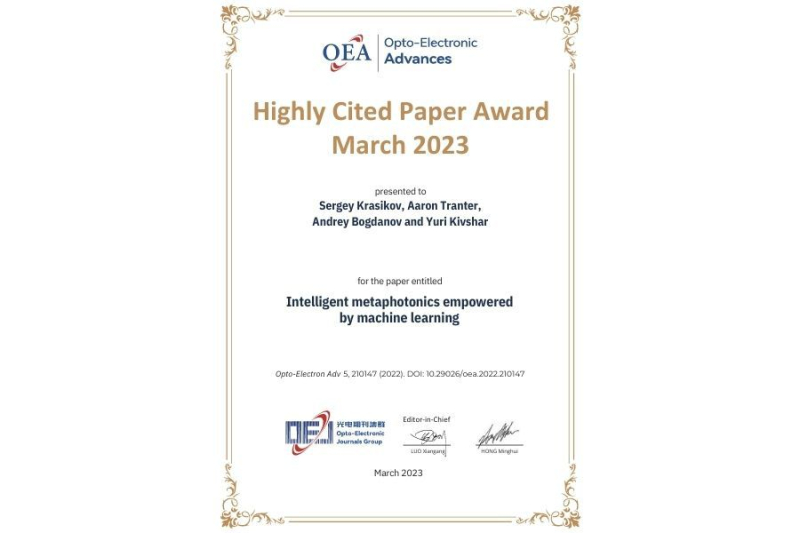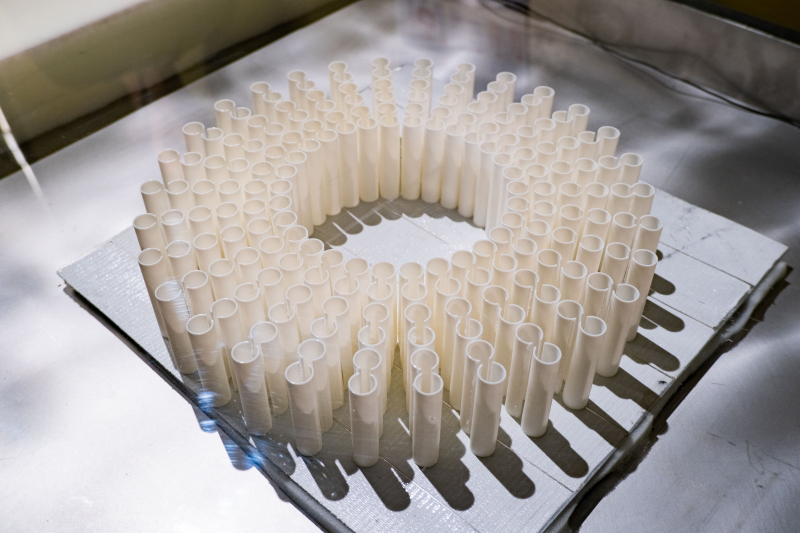The review, authored by researchers from ITMO and the Australian National University, was published in the WoS-indexed journal Opto-Electronic Advances in March 2022, and currently has an impact factor of 8.933. Since its publication, the paper has been cited 22 times, landing it in the top 1% of the most commonly cited papers, according to WoS.
A total of 195 papers were placed in the top 1% in the field of optics. The list was ranked not only according to the number of citations, but also the time period over which they were made, as it can indicate a highly relevant paper.
Moreover, the review article received the Highly Cited Paper Award March 2023 from Opto-Electronic Advances. It is featured among the top 30 most cited and read papers published by the journal.

Certificate of the Highly Cited Paper Award. Image courtesy of the researchers
“In our article, we aimed to showcase the potential of modern technologies. We wanted to present a broad overview of the field of metaphotonics, outline new trends, and pinpoint potential new directions,” says Sergey Krasikov, the paper’s first author and an engineer at ITMO’s Faculty of Physics.
These days, scientists use information technologies for interdisciplinary studies involving different areas of physics, such as metaphotonics, radio physics, and acoustics. For instance, researchers at ITMO’s School of Physics and Engineering use machine learning to design acoustic metamaterials and metasurfaces, which can be used in noise-insulating barriers in urban environments.
Recently, researchers presented a structure that decreases noise by up to 20 dB within the spectral range of 2 to 16.5 kHz, covering 70% of the audible bandwidth. But with the help of AI, they will be able to improve these results even further and provide detailed explanations for the effects observed in their experiments.

A prototype of the new donut-shaped noise-insulating structure. The solution is made up of pairs of coupled Helmholtz resonators – 3D-printed vertically-oriented tubes with an opening on one side. The structure is translucent and vented. In the future, researchers plan to run tests on a prototype with larger resonators. Photo by Liliya Kichigina / ITMO’s School of Physics and Engineering
“In our work, we rely on optimization algorithms, including machine learning, to find the most efficient designs for our noise-insulating structure with the best performance indicators. We also apply machine learning in more applied tasks: for example, we develop algorithms that will predict solutions to equations based on our data. These methods have the potential to replace computational modeling because they are faster and don’t require as much computing,” adds Mr. Krasikov.
The review also considers other subfields of metaphotonics that would benefit from machine learning, including the design of nanoantennae for solar cells, which might become a major energy source in the future.
Moreover, AI can facilitate the optimization of metasurfaces for highly sensitive bio- and chemical sensors that could serve as real-time diagnostic tools for various maladies. Another way that AI can improve the sensitivity of such systems is by interpreting test results – potentially, AI systems can detect patterns that wouldn’t be observed by a human.
Read also:
A Quiet Place: ITMO Physicists Reduce Noise Tenfold With Metamaterial Structure
Paving the Way to Next-Gen Devices: Your Guide to Metaphotonics
Web of Science (WoS) is one of the world’s largest bibliometric systems, indexing the leading journals, books, reviews, and other academic literature. According to Clarivate, WoS’ parent company, the system contains information on over 160 million publications in 254 fields. By analyzing this information, it is possible to track the most cited publications and the most influential researchers, who receive special awards for their contributions to science.





